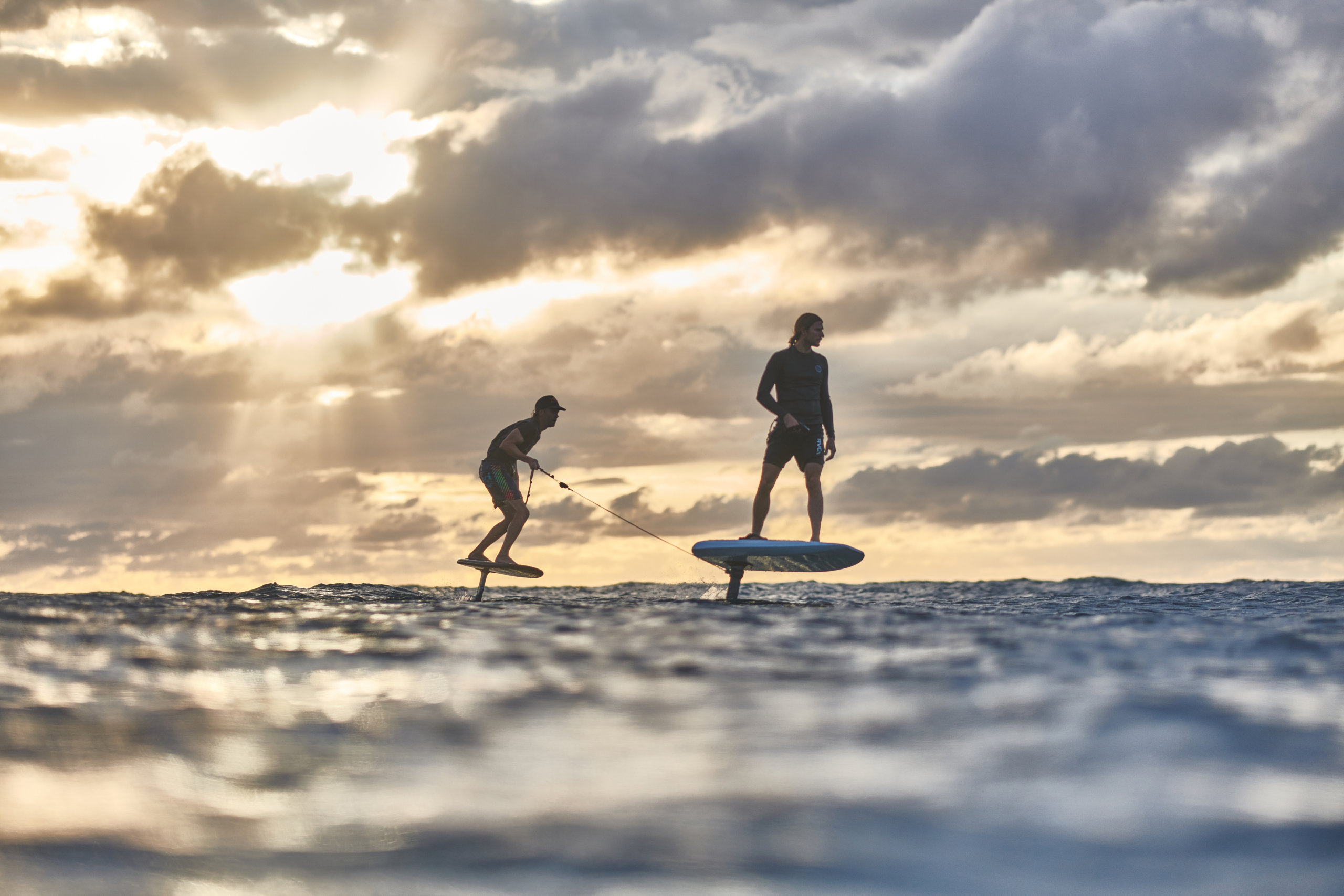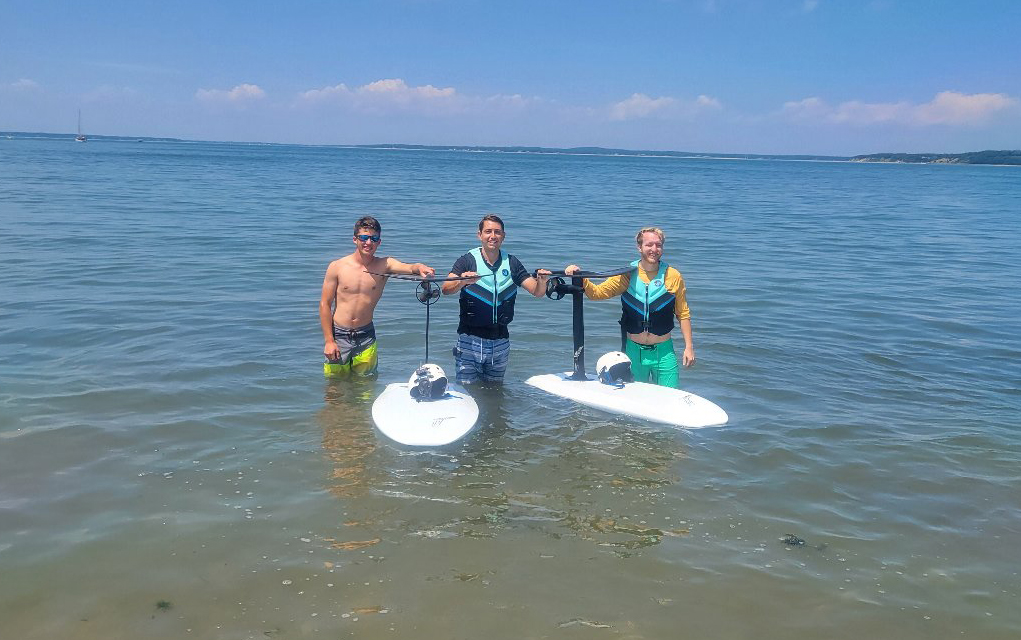Testing the Waters of eFoiling with Hamptons Lift Foils

Living near the water, many of us have probably seen what appears to be a surfer floating over the tide at the tip of a pole — this foil surfing, or foiling, is often considered a more challenging cousin to traditional surfing intended for thrill-seekers who don’t want to wait around for a big enough wave to surf the traditional way. Then came eFoiling, which introduced a motor and wireless accelerator that negate the need for wind, waves or actual foiling to make the whole experience more accessible.
When the company that created efoiling reached out about a demo to show off the technology in action, this reporter strapped his brother Daniel Taylor, a surfing and electric skateboarding enthusiast, into a life vest and headed with him to Noyac.
The company, Lift Foils, is a family-run operation based in Puerto Rico that was founded by engineer and surfer Nick Leason. Having sold their first board in 2018 after five years of research and development, Lift Foils’ eFoil technology has been gaining popularity over the years, sparking the company to open affiliate locations, such as the new Hamptons Lift Foils in Sag Harbor.
We met Jeremy Stauffer of Hamptons Lift Foils at Noyac Bay for a test run on the Lift3, the third generation of the eFoil technology. He showed off the carbon fiber board, the lithium-ion battery hidden inside, the hydrodynamic shroud and aluminum propeller.
The board is rather light and comes in four lengths from 4’ 2” to 5’ 9” though the removable battery inside adds about 30 lbs if transported together. Taylor was then handed the Bluetooth hand controller, similar to the one he uses with his electric skateboard, except this one is waterproof, buoyant and has a strap to reduce the chance of falling off.
Having picked up surfing relatively quickly, Taylor seemed confident he’d pick up eFoiling just as easily. While not entirely untrue, his watersports skills could only take him so far when his board lifted from the water and into the air.
“The first part is easy, where you’re just kind of coasting on the water and it’s very familiar for those who surf or paddleboard, that feeling of bouncing on the water,” Taylor says. “Then when you build up speed and lift that front foot up ever so slightly, that’s when you start to fly, and that’s when it’s a whole different ballgame that you’ve never experienced before. It’s very Jetsons future-feeling where you’re just flying and are like, ‘This is now a hoverboard.’”
Splashing into the bay several times during his first-ever half-hour of eFoiling, Taylor can attest that the fundamentals of skateboarding and surfing, such as weight distribution and foot placement, do carry over into eFoiling, but the learning curve is still there, which makes the demos and lessons that Hamptons Lift Foils offer all the more helpful to those who’d prefer to get good at the sport before investing in their own Lift Foils eFoil.
“Surfing helps. Skateboarding helps … but the minute you’re in the air, it’s completely different. You’re like, ‘I have never felt this before,’” Taylor shares. “It’s definitely a whole different beast, where if you have surfing experience it’s fun and a little bit easier, but you’re still learning a new sport.”

As he began to understand the differences and similarities to surfing, Taylor explains that he was able to control his direction by turning his head in the direction he wanted to go, adjust height above the water by shifting his weight between his feet and come to a stop by letting go of the accelerator and allowing water resistance to do its thing.
“It definitely felt like I was in control,” he says. “It was super fun, very safe and very-much-so a full-body workout.”
When he did nosedive into the water, letting go of the accelerator on reflex, the board would stop behind him allowing Taylor to swim back to it easily. Accidentally losing his grip on the controller once, he was pleased to discover it floating nearby, but he does advise prospective buyers to look into neon cases to help the black device stand out a little more.
The design of the Lift eFoil allows it to maintain speed without the act of foiling up and down above the water. Its top speed of 30–35 mph may sound like a leisurely drive for a land vehicle, but for this personal watercraft, touted as the world’s smallest, it’s likely to boost one’s adrenaline.
“I didn’t realize how I gentle I was being with the speed until he (Jeremy Stauffer) was saying, ‘Put more speed on it.’ I was like, ‘There’s more? How fast am I going right now — 15 or 12 (mph)?’” Taylor says. “The speed that you saw me going was less than half of what it can go. That’s insane, because that already felt pretty fast.”
With a battery that lasts about 100 minutes, Taylor’s demo Lift3 was likely nearing the end of its charge, but he reports no slowdown or jerking, which personal electric vehicles are prone to when they reach a low battery charge. Stauffer added that when the eFoil is nearing the end of its charge, it will emit a sound to alert its rider to head back toward land.
The Lift eFoil model Taylor tested, the Lift3 with full range battery, retails for about $13,000, while the heavier Lift3 F model with light battery goes for about $10,000. These watercraft are designed for flat bay waters, with ocean beaches and choppier waters requiring a traditional non-motored Surf Foil.
While Taylor will have to resist the urge to drop a couple thousand on a Lift eFoil for now, he does plan to take advantage of Hamptons Lift Foils’ individual and group sessions and rentals. Those living on the South Fork and Shelter Island can email hello@lifthamptons.com to inquire about setting something up.
To learn more about Hamptons Lift Foils, visit lifthamptons.com, and to peruse the full lineup of customizable Lift eFoils and Surf Foils, visit liftfoils.com.



